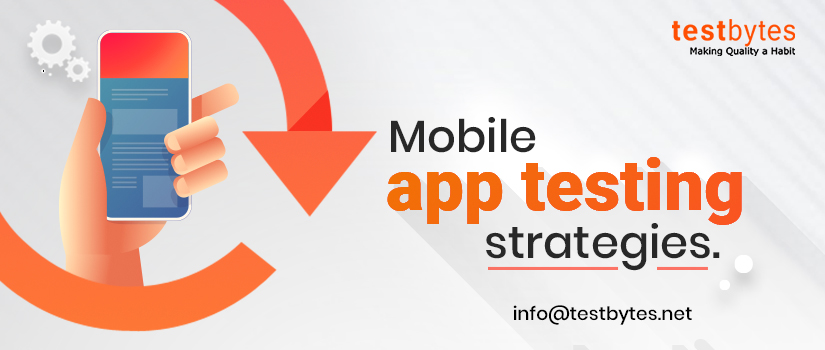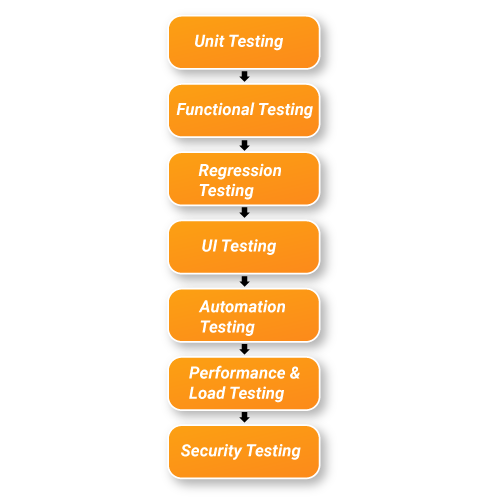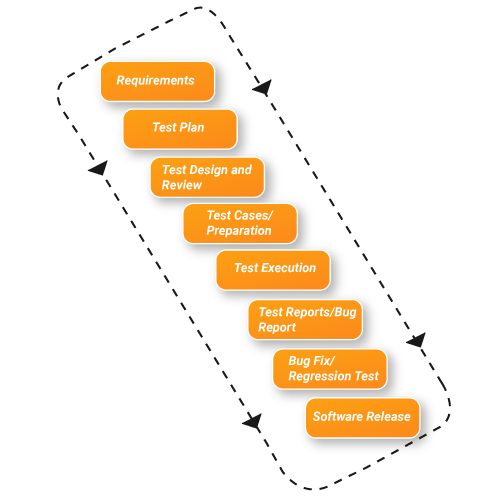
11 Effective Mobile App Testing Strategies
November 18th, 2020

Having a good strategy in testing an app is as important as having a good test plan. Effective mobile app testing strategies will make sure that maximum efficiency is maintained and the cost is kept at bay.
let’s have a look at effective mobile app testing strategies.
What and why we need a mobile app testing strategy?
A strategy is very important to achieve a goal. It lists out the things to do as part of testing to achieve the quality objective with maximum coverage in the available time.
Regarding mobile applications, the time to market is reducing with every passing day.
To beat the competition you need to launch your mobile app with excellent quality asap or at least before your competitor. This is where the importance of a testing strategy comes in.
A testing strategy aims to ensure good quality, high performance, and maximum test coverage in a limited time. Here are a few things that need to be covered as part of a mobile app testing strategy:
- Devices: There is an exhaustive list of mobile devices available in the market. This count is also increasing exponentially. This makes it close to impossible to test your application on all devices. The best option thus would be to design a strategy to select the devices based on the adoption in that particular market or based on the expected user base.
- Emulators/Simulators: Another more viable option would be to go in for emulators and simulators. This way you will be able to get more coverage of the devices with limited cost.
- Types of testing: One of the main objectives of designing the test strategy would be to list out the different types of testings needed for the mobile application. This would be based on the functionality of the mobile app, the markets it is launched in, the expected user base, and many more.

What’s the difference between a mobile app test plan and a test strategy?
Test strategy and plan are often used together and also interchangeably. But they are not the same. There are subtle differences between a mobile testing plan and mobile testing strategy. Let us look at some of these differences below:
| Mobile Test Plan | Mobile Test Strategy |
| A plan would include scope, objective, and the effort required to perform the mobile app testing. |
A strategy is essentially a guiding document that determines how mobile app testing should be done. |
| A mobile app test plan would include the details of the testing process like the requirements tested, entry, and exit criteria, the testing timelines, pre-requisites, etc. | A mobile app strategy document, on the other hand, would include the team organization structure, testing status communication structure, communication strategy, and other such details. |
| A mobile app test plan is prepared at a team level by the team lead for circular within the project and testing teams. | A mobile app strategy document is prepared by the test manager for presentations at the leadership level to understand the plan for testing. |
| A test plan is at a project level and specific to that project alone. It includes requirement mapping and can not be used for other projects. | A test strategy for mobile app testing would be a generic document that can be leveraged for other similar projects as well with some modifications. |
| A mobile test plan can easily be changed with concurrence from the respective stakeholders. | A strategy is a more rigid document that does not change after each iteration or project. It is ideally a directional or guiding document for the testing efforts. |
Know More: Wish to know how to test a mobile app?

What are the different types of effective mobile app testing strategies?
Here we look at the different types of testing strategies that must be part of your mobile app testing strategy document to achieve a good quality product.

Strategy no: 1 Cross-Platform Testing
There are different types of mobile OS available in the market. The main being android and iOS.
It is essential to plan to test the mobile application on all platforms to ensure the application works as expected on all platforms.
Most applications will have a separate code set for android and iOS, hence it is important to test the application cross-platform to find any issues.
Strategy no: 2 Functionality Testing
The main testing has to be related to the functionality of the application that we are developing.
The USP for any application is how well it performs the task it is intended to. So, it is very important to test to complete functionality in and out.
Every flow in the application needs to be tested to ensure there are no broken functionalities or flows.
Strategy no: 3 Type of application
There are mainly 3 types of mobile applications
- Native application – the ones developed specifically for the Android or iOS platform
- Mobile Web application – browser-based applications on the mobile phone and
- Hybrid – a mix of the above two
While planning for testing, good coverage is needed for all three types of applications to ensure stability and performance.
Strategy no: 4 UI and UX testing
The user interface (UI) and user experience (UX) are the next things that need to be planned well without fail.
The user interface is what the users see and how they interact with your mobile application.
The UI should be designed in a way that it is to understand and navigate through the app for all categories of users.
Similarly, for UX also the navigation between the pages and the time taken to generate the reports of output as per the application should be well within the pre-defined SLA.
With the numerous mobile apps available in the market today, your app may not get a second chance if the consumer or end-user does not like it.
Strategy no: 5 Backend Testing
Backend testing is done to ensure the data is getting stored in the right places and in the right format.
During the testing, we need to ensure that the data entered by the user is saved correctly, against the right profile, and also it should be easily retrievable.
Backend testing also involves checking the different places where the data is saved and reflected in the application and that it is done correctly.
Saving and retrieving the correct user profile would be another major use case for backend testing.
Strategy no: 6 Network compatibility Testing
Mobiel applications behave according to the variances in internet strength
In this case, network compatibility testing needs to be included in your test strategy as well.
This will include testing the application in different network configurations like with data and wifi.
Different signal strength, bandwidth, and then measuring the TPS (transactions per second) to see if is within the planned SLA.
Strategy no: 7 Storage Testing
Storage testing has become an important part of the mobile app testing strategy very recently.
With the growing number of apps being used and limited space available for use.
People tend to avoid apps that need too much space to download or more data to use.
Thus it is important to check and rectify these parameters for better acceptance from the end-users.
Strategy no: 8 Data flow testing
Most mobile applications are not stand-alone and need one or the other input from systems and servers outside the app.
It thus becomes an important part of the strategy to include the testing of the data flow from one system to the other.
Strategy no: 9 Localization Testing
While this may not be needed for all apps, if needed it would be good to have in your strategy.
Localization testing involves testing the application for location-based parameters like language, maps, and any other things related to the locations. These are sometimes legal requirements also for some locations.
Strategy no: 10 Device Testing:
There are a plethora of devices in existence now. To make sure that your app is working fine on all of them you need to check the app’s performance, functionality, and UI on real devices.
It’s a challenging as well as a daunting task. And there are thousands of devices with varied screen size out there. So in this situation depending on emulators has been seen as a common practice.
But it’s true that emulators are not an absolute solution. So the perfect solution here would be to test the app in screen size that’s commonly used and then for other options use emulators.

Mobile App Testing Strategy for Agile Projects
Agile is a relatively new buzzword. It translates to faster time to market, more flexibility in terms of features, frequent deliveries, and better results.
While everyone agrees on the importance of testing and quality, the testing window in Agile is usually very less.
Hence, in addition to what is already discussed in the previous section here are some pointers that need to be considered as part of the mobile app testing strategy.
- Early Testing
To start with, testing has to start as early as possible in the sprint. Even if the code can not be moved to a separate QA or stage environment, plan to test in lower environments to get the initial results that the team can work on.
- Establish an alignment between the dev and testing team
There is a dire need to set up a communication channel that can help team members be aware of the changes happening this includes the changes in development and testing.
Using tools for code check-ins and bug tracking is also helpful in keeping the team informed.
- Infrastructure Readiness
Mobile application testing is dependent on real devices and simulars.
Ensure these are made available in sufficient number with a buffer so we do not end up with damaged and non-functional devices which will eventually eat up the already crunched test window.
The availability of a stable test environment before the sign-off should also be part of the strategy.
- Exploratory Testing
Testers with expertise in mobile application testing would be able to pinpoint the problem areas in a mobile application based on their previous works.
Hence exploratory testing should be added to the strategy to ensure we can get maximum coverage in lesser time. This also helps to prioritize the areas of testing and channelizing the efforts in the right direction.
- Automation Testing
By automating the requirements and features from the first iteration itself will give you time to work on new and more business-critical features.
Thus the mobile app testing strategy should focus on implementing an automation framework that can be scaled-up and utilized over the different iterations and beyond.
Final Thoughts…
The strategy is what drives the team towards working on the common goal of best quality and performance by your mobile application. So, it is very important to have a well-thought-out and detailed mobile app testing strategy document with a futuristic view.
A mobile app testing strategy is like an anchor for a ship. It steers it in the right direction and helps the ship to reach its destination safely and happily.


 Software Testing Events
Software Testing Events App Testing
App Testing Web App Testing
Web App Testing Game Testing
Game Testing Automation Testing
Automation Testing Load Testing
Load Testing Security Testing
Security Testing Performance Testing
Performance Testing Hire a Tester
Hire a Tester





